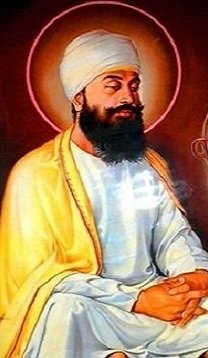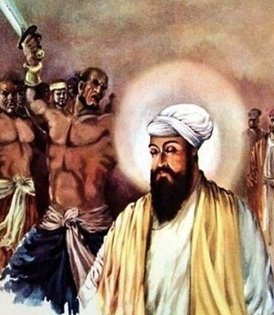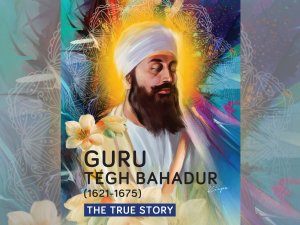The author was approached by Campaign for Nuclear Disamarament (CND) Peace Education to give a Sikh view about nuclear weapons and disarmament. The faith response is for school religious education (RE) teachers and aimed at middle and senior school students. The topic is complex and the author hopes that the RE teachers would study and simplify further according to student age groups.
The short questionnaire is limited to a few words against each question. Below are some relevant introductory thoughts shared with the readers followed by the completed questionnaire.
Introductory discussion
Sikhi (Sikhism) allows armed defence as a last resort when all other means for securing peace have failed. The only peace acceptable to Sikhi is genuine peace which secures human freedom and dignity in a just society. Sikh activism is aimed towards the establishment and defence of such an ideal society.
Armed defence is also confirmed by the principle of “Degh Tegh Fateh” meaning victory of the cauldron defended by the sword of justice. Here, literally, degh, is the large metal container (ਕੜਾਹਾ) for cooking community food (langar) in the community kitchen. Therefore, “Degh” symbolises the sharing principle in Sikh tradition. It represents a way of life, of sharing with those in need and community service, a social system which is defended by Tegh, the protective sword of justice of the Khalsa Panth.
Tegh is symbolised by the Sikh sword, “Kirpan”. The word means “the benevolent defender of honour or human dignity”. Kirpan also represents all weapons intended to be used for defence only; and, ultimately, the divine power which protects the defenceless.
Un-armed Sikh response to aggression: This is also the place to summarise un-armed response to aggression in Sikhi tradition enshrined in the unique Sikhi concept of martyrdom (shaheedi). It can be distinguished from “ahimsa”, the principle of not causing harm to other living things. It is certainly not “satyagraha” as a policy of passive political resistance practised by Mahatma Gandhi against British rule in India. Satyagraha strategy relied on threat of fast unto death (maran-barat). That strategy is anti-Sikhi. Often, there is doubt about the effectiveness of such self-inflicted death. In any case, many such maran-barats are just political gimmicks.
Below is a summary of the Sikhi concept of martyrdom from my revision of earlier publication Guru Tegh Bahadur: The True Story.
(Link: GuruTeghBahadurJi-TheTrueStory.pdf (sikhmissionarysociety.org) )
The Guru preached realization of the higher spiritual and moral truths above material attachments, physical pain, passions and pleasure. By contrast, the Indian idea of 'vairag' was based on dislike for worldly life. Shankracharya preached contempt for worldly pursuits and recommended isolation from temporal living. He believed that only such detachment from the world can induce a state of vairag.
The Guru’s concept of vairag was based on love for the Creator Being above worldly attachments and pursuits. God-love was then translated into love and sacrifice for God’s creation.
The Sikhi concept of martyrdom, sacrifice in God-love for the righteous cause and assertion of the human right to free choice to seek own path to God is the message of Guru Tegh Bahadur’s martyrdom. In one sense, Guru Tegh Bahadur’s holy hymns bring together the best of ancient Indian thought relating to detachment (vairag), albeit, re-interpreted, and the Greek-Abrahamic concept of martyrdom (shaheedi).
To quote Gurbachan Singh Talib:
“In the Guru’s teaching an added element, which is the crown of the higher life, is the pursuit of the ideal without flinching uptill the stage where it may become martyrdom…..The dimension of the reality of physical evil, which neither prayer nor miracle may avert, but which must execute its potential movement, is what makes Guru Tegh Bahadur’s teaching so deeply touching and of such value to our time in which miracles of the kind narrated in mythology are not known to occur……This implies not their [devotees’] rescue from the power of tyrants and oppressors, but the triumph of their spirit and the fulfilment of their ideals despite their physical destruction.” ( Fauja Singh and Gurbachan Singh Talib, Guru Tegh Bahadur Martyr and Teacher, P1975)
CND Peace Education religious leaders’ questionnaire
Are you for or against nuclear weapons? Why? (Here, the justification should describe one’s own personal opinion, and can be brief, to allow for deeper enquiry in the later questions) 50 words.
As a Sikh, I am for multilateral nuclear disarmament but against unilateral surrender of power to totalitarian regimes. Nuclear weapons are a glaring misuse of God-given knowledge, a global threat to human existence and a major distraction from human progress towards an ideal global society.
How has your faith informed your opinion on nuclear disarmament?
Sikh teachings tell me that human life is precious and that human beings have the God-given right to live with dignity. However, as a last resort, to struggle against oppression to the death is better than living a life without dignity. Therefore, to quote the Tenth Master, Guru Gobind Singh,"When all peaceful means fail, armed resistance against oppression is justified.” The Sikh Kirpan, meaning: the sword which defends human dignity, also symbolizes armed defence of an egalitarian way of life against all weapons - conventional or nuclear. Global nuclear disarmament depends on tackling the root causes of war by diverting human thought and energy away from material ambition and greed, to God-centred moral values and truthful living.
[Article link: A Sikh Approach to War and Peace (sikhmissionarysociety.org) ]
Is there a particular teaching that you consider to be important regarding nuclear weapons? E.g. a parable, verse, practice or belief.
As nuclear weapons are a modern invention, world religions can only be guided by general principles. Guru Nanak’s compositions lamenting the carnage caused by Babur, the Mughal invader of India, are instructive. The compassionate Guru implored the Creator Being that if a powerful aggressor is faced by an equally powerful defender then there is no cause for complaint. However, when ordinary households are left defenceless and will be killed, they deserve divine intervention. No one should be left defenceless against conventional or nuclear weapons while human endeavours for global peace continue.
Does your faith have a history of working against weapons of mass destruction? If so, can you give examples?
Sikh teachings, history and activism are about peaceful co-existence and defence of human diversity and dignity. There is no distinction between knives and nukes if used for aggression. Therefore, in forums and peace movements, Sikhs oppose use of all weapons which are not solely for self-defence of individuals and people (communities and nations).
Can you share something from your faith that exemplifies your faith’s approach to peace and nonviolence? E.g. a particular belief, story, practice or writing.
Sikh teachings enshrined in the Sikh Holy Scripture, Guru Granth Sahib, include those of Muslim and Hindu saints. A Guru martyr, Guru Tegh Bahadur, gave his life in defence of the universal principle of religious freedom. At that time the aggressor was Muslim Emperor, Aurungzeb, forcing Hindus to convert to Islam. Yet, Muslim saints have a place of honour in Sikh teachings as mentioned above. Guru Granth Sahib exemplifies world peace and full acceptance of human diversity. Historical Sikh non-violent campaigns – the morchas – against colonial rule won applause from leaders like Mahatma Gandhi and also from the colonial British themselves.
What does a peaceful future look like to you? 1 or 2 sentences.
A peaceful future is well illustrated in Guru Granth Sahib as one when no one inflicts pain on another. It is a future in which global citizens have no worries (Begumpura concept) and they can move around fearlessly and freely.
Gurmukh Singh OBE
E-mail: [email protected]
20 January 2021











